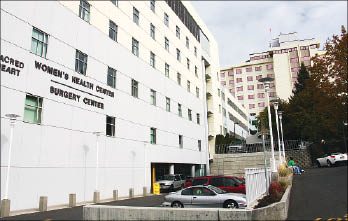
Home » Health care looks relatively strong
Health care looks relatively strong

December 18, 2008
The Spokane area's health-care sector is expected to be fairly strong in 2009, with added hiring and sizable capital expenditures, although huge government budget woes have hospital executives concerned about reimbursement levels.
"The issue for us is certainly not demand at this point, but it is clearly the state and federal budgets," says Mike Wilson, president of Sacred Heart Medical Center & Children's Hospital, the Inland Northwest's largest hospital.
Sacred Heart will monitor state and federal budget negotiations closely next year, and will take whatever steps are necessary to respond to changes in the government payments it receives, Wilson says.
He says Sacred Heart is budgeting for a roughly 2 percent increase in patient volume and revenues next year, but adds that's a conservative estimate. It budgeted for similar increases this year, but actual growth has been closer to 4.5 percent.
Sacred Heart expects to kick off a five-year capital investment spending program next year that will include a new cancer center and doctors' building and that's expected to cost at least $220 million to $235 million in construction and $150 million for equipment. The overall project will add 173 licensed beds to the 623-bed hospital, plus another nine unlicensed beds.
Sacred Heart currently employs about 4,750 people in all, with a full-time equivalent work force of about 3,400 employees, and he expects those numbers to grow next year.
Meanwhile, Deaconess Medical Center and Valley Hospital & Medical Center have been spending millions of dollars on new equipment, thanks to an infusion of money by Franklin, Tenn.-based Community Health Systems Inc., which acquired most of the assets of Spokane nonprofit Empire Health Services in October for $156 million. Community Health Systems has agreed to make $100 million in capital improvements at the two hospitals over the next five years, and said it would spend $10 million just in the first 90 days.
Deaconess' new CEO, Dennis Barts, said in an interview this fall that any significant increase in admissions at the 388-bed hospital next year will depend on how successfully the hospital can recruit physicians to practice there.
As of October, Deaconess had about 1,650 employees, down from a peak of 1,900 in 2002, and Barts said he didn't foresee a quick turnaround in employment there, but expects "some growth over time as we build our services."
Holy Family Hospital, which currently has the equivalent of about 980 full-time employees, expects growth of 3 percent to 5 percent in most facets of its operation, says Tom Corley, its president.
"The volumes will be strong," as they have been this year, Corley says. Given government budget pressures and the effects of job losses in reducing health insurance coverage, though, he says, "The trick here is going to be will we have adequate revenue to support the care that we think is vital to our patients."
Because of the tighter reimbursements and the tighter economy, Holy Family may decide to put a temporary hold on noncritical capital expenditures, such as an ongoing conversion of most of the hospital's semi-private patient rooms into single-bed private rooms, he says.
Separately, Washington State University is getting ready to open its new five-story, 80,000-square-foot College of Nursing building on the Riverpoint Campus that will create additional health care-related employment near downtown. Also, it has reached a preliminary agreement with Denver-based NexCore Group LP for development of a 60,000-square-foot medical building at Riverpoint in the first phase of an anticipated three-phase development.
Work on that phase is expected to start next year.
Latest News
Related Articles



